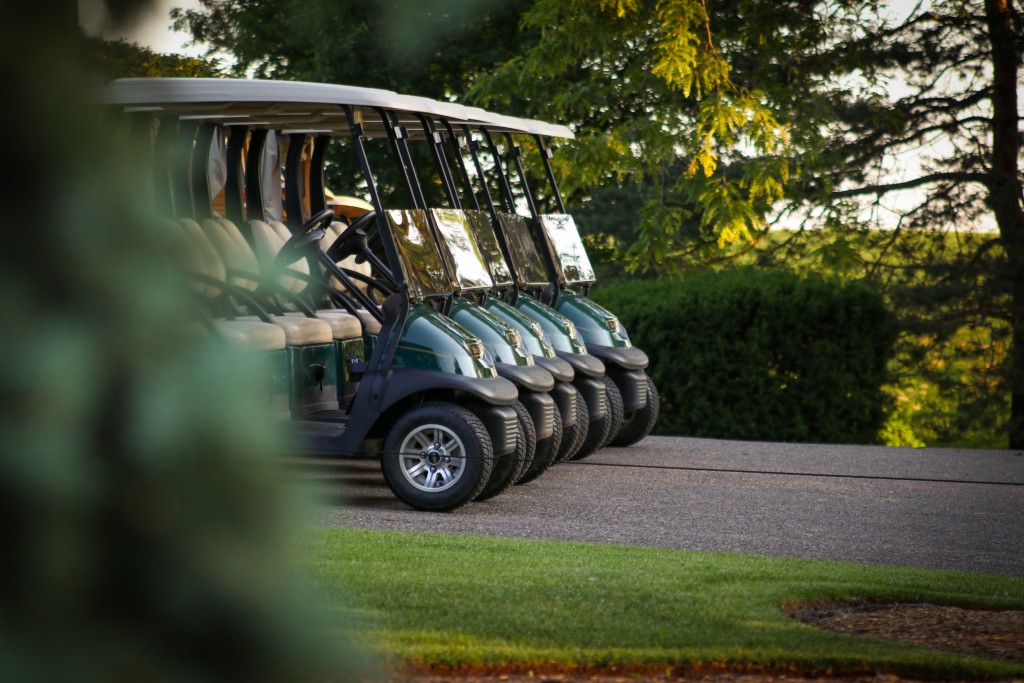Green fee coupons and punch cards. Walk-on primetime rounds and twilight deals. Group discounts. Wink-wink sales pitches from private clubs. And, best of all, beautiful, birdie-bearing conditions on golf courses private, public and municipal.
Colorado golfers, the golf industry wanted us that badly. Course operators tried everything, from luring newbies with introductory clinics — some accompanied by wine and cheese — to training staff on being nicer. Still, their business refused to grow, so they buttered our bread with sweet deals.
Then, on a lovely spring day in 2020, a pandemic stopped the world and jumpstarted golf, which showed itself to be a safely distanced yet highly social form of exercise for people of all ages – especially the white-collar worker who could shut down work-from-home for a late-afternoon weekday 18.
Now, Tom Buzbee, director of golf at Flatirons Golf Course, can’t get out and play a round with his wife because his Boulder municipal course is so busy he’s got to go online at midnight a week before he wants to play. “We’re getting trampled,” he says. “Twilight is evil. Why would I offer a discount? Greensaver, Golfnow, they’re long gone. I kicked them in the trash. There is no discounting anything, because I can sell those tee-times at full price. And this golf course had struggled for years to break even. We’re finally able to hold our head above water.”
Ed Mate, executive director of the Colorado Golf Association, found himself getting up at midnight to try to get a particular tee-time at the new City Park in Denver – and failing! The CGA membership, made up of all the Coloradans who join affiliated clubs, increased an unprecedented 10 percent, to nearly 70,000. “Why should the operator do anything to incentivize in this market?” Mate says. “Just the opposite. If you play (CGA home course) CommonGround on a Tuesday, you’re going to pay the same amount you’re going to pay on Saturday, because the new worker has that flexibility. What I see as the smart strategy when it comes to discounts and incentives now is no strategy.”
Simple economics, says J.J. Keegan, who consults with daily fee and private courses to optimize profits: “For so many years, we have dealt with such an excess of supply and discounting of the rates that have resulted in many courses barely breaking even, deferring capital expenditures. And what we’ve seen in the last two years is a return to where golf courses are now generating cash flow. Revenue was up 20 percent last year, so it’s not good for the golfer.”
It might be good for the golfer who can afford $65,000 to join the Club at Ravenna, the only private club in the Denver Metro area without a waiting list. But even there, with a new clubhouse due to open this spring, initiation increased $20,000 the first of the year.
The rest of us can’t get a tee time, much less a sweet deal. Loyalty means nothing, unless you’re talking about the perks that come along with the Denver Golf Loyalty Card. And that, by the way, was free last year but now costs $40.
It’s not going to be a good year for the pre-COVID golfers used to being spoiled, coddled and courted. Here are five trends we’ll see instead in 2022.

1. The end of emergency golf
“In this market, if you think for one moment on a beautiful summer day that you’re going to call a property and find availability, it’s like trying to get Valentine’s Day dinner reservations at 7 o’clock by calling the night before,” says Fossil Trace Golf Club head professional Jim Hajek. “It’s not going to happen. If it is, if there’s currently space available on your golf course, they should just plow the place under.”
Hajek estimates that his course filled 98 percent of its tee times the last two years. Scott Rethlake, director of golf for Denver, says simply that on beautiful days, the city’s six 18-hole courses are full.
In the old days, one might hang out at the putting green (or the bar) hoping for an opening, particularly in the late afternoons.
“We’ve changed behavior so that people are getting better at cancelling,” Hajek says. “You could be hanging out here quite a while with the hope of getting on and actually not be able to get on. Which I hate because we’re here to take care of people and that doesn’t feel right to me.”
So if you don’t have a tee-time in 2022, you might as well stay home.
2. Waiting lists and higher fees for private courses
Private clubs in the area won the hearts of their members by providing what Mike Hestera, general manager of the Club at Rolling Hills, calls “safe haven” during the heart of the pandemic. “We were a place where our members felt safe,” he says. “They were outdoors and had an opportunity to recreate and enjoy one another’s company. And instead of going to their old standard restaurant where they weren’t quite comfortable, they’d come to the club.”
Families, especially, took to golf as they never had before. Initiation fees and monthly dues increased, and clubs like Cherry Hills, Lakewood and the Country Club at Castle Pines made assessments for new amenities and clubhouses. Nonexistent waiting lists grew long.
“For a full golf membership, it’s a three to four-year wait to get into Rolling Hills,” Hestera says. “Over the course of the last year, our club has seen record usage – probably three years’ worth of golf in two years. That sounds great, but there are challenges to that.”
 Inside the gates at Ravenna, Director of Golf George Kahrhoff set up a system where he’d greet members in the parking lot, get clubs loaded onto carts, take food and drink orders and call the restaurant, which would put everything on a table for pickup. One day, he noticed that a member of another club was playing as a guest for the third or fourth time.
Inside the gates at Ravenna, Director of Golf George Kahrhoff set up a system where he’d greet members in the parking lot, get clubs loaded onto carts, take food and drink orders and call the restaurant, which would put everything on a table for pickup. One day, he noticed that a member of another club was playing as a guest for the third or fourth time.
“What, you can’t get onto your own course?” Kahrhoff said, half kidding.
“I can’t!” the man said. “I have to come over here as a guest to play.”
“There was an uptick in people joining clubs because they had trouble getting tee-times,” said CGA’s Mate. “Then they found they were in a club and they still couldn’t get a tee-time!”
Ravenna, still short of the cap of 395 golf members set by owner Kevin Collins, added 39 in 2020 and 103 in 2021. Its location south of Littleton’s Chatfield Park had handcuffed sales until the advent of work-from-home and a real estate boom that is expected to bring as many as 12,000 homes to nearby Sterling Ranch. Now, all of its 243 lots are sold, and Kahrhoff continues to get membership inquiries from public golfers fed up with the tee-time frenzy and five-hour rounds.
“The No. 1 thing people want is open tee-times,” says Kahrhoff, who has trained members to use an app to find last-minute slots on the course. “Second is pace of play. And third is course conditions.”
3. The grass is definitely not greener on the other side of COVID
With November came Colorado golf’s official offseason, when rain and snow nurture the dormant grass on the fairways and greens for spring.
But the fall rolled in as dry as the summer had rolled out. Aurora set up a closure rotation so that each course periodically had a day off. Foothills and Flatirons prohibited golf carts altogether. Most courses with continuous cart paths went cart-path only. And Denver shocked its players, many of them used to years of low rates and perks, by raising cart fees $6 a person until May 1.
“We wanted to give our golfers an opportunity to ride if they wanted to,” Rethlake says. “But we had to figure out a way to raise some additional funds to pay for repairing that damage come springtime.”
It’s not even about newbies doing wheelies on the turf: This was the price of normal wear and tear with courses filled to capacity in a drought.
“A lot of times in the winter, golfers say, ‘I should pay a reduced green fee because I’m not getting in-season conditions,’ ” Mate says. “And my answer is, ‘No, you should pay twice the green fee because you’re doing 10 times the damage when you’re out there.’ With climate change, we’re having to think a little bit differently, and maybe we’re going to have to just close our golf courses in the winter. If there was an initiative among superintendents to close in November, December, January every year, oh, it would be 100 percent. But the revenue is nice to have.”
4. Charity ends at the clubhouse
Have a group of 40 that wants to run a little fund-raising tournament with tee prizes and a post-round luncheon? Better have 10 players up at midnight to get those tee times.
“In 2022, we project that golf courses will not be holding tournaments or outings less than the full capacity of a golf course, at 144 players,” says the consultant Keegan. “An outing of 40 players is going to have difficulty finding courses that are going to be willing to host them. The additional requirements of staging it, scoring it, hosting it make it far more labor intensive than just play.”
And why bother with extra work when those tee-times are flying off the shelves? “Tournaments were always a big part of financial viability,” says Buzbee, whose Flatirons went from averaging 32,000 rounds annually to 48,000 the past two years. “We used to give the groups discounted green fees, free range balls. I’m filling the tee-sheet with full-price-paying people every day. We don’t need to have an outing or a group or an event. If we do, I charge them full price.”
 Private courses traditionally bring in extra income with Monday tournaments and outings. But many have curtailed access. They have double incentive to protect tee times from the public: There’s too much tee-time demand inside the club, and a new law taxes the member-owned 501(c)(7) on revenue it brings in from the outside.
Private courses traditionally bring in extra income with Monday tournaments and outings. But many have curtailed access. They have double incentive to protect tee times from the public: There’s too much tee-time demand inside the club, and a new law taxes the member-owned 501(c)(7) on revenue it brings in from the outside.
Even state championships and USGA qualifiers are scrambling for venues.
“We rely on the generosity of golf courses to host our tournaments,” Mate says. “It’s always been hard, and now it’s becoming impossible because the membership is playing a lot of golf. They don’t want to displace their members.”
5. Think ahead, way ahead, and pay the (dynamic) price
There’s still hope for the public golfer. It’s a good time to join a league, if you can find one with openings, or buy the Denver Golf Loyalty Card for $40 for tee-time access 14 days in advance instead of seven.
The most upscale Denver Metro public-access courses – Fossil Trace, Arrowhead, Bear Dance, Green Valley Ranch and the Ridge at Castle Pines – offer 90-day advance tee times at a premium. Fossil Trace started taking bookings for the entire season March 1, and next year may start as early as Dec. 1. So if you have friends visiting or a special occasion ahead and you don’t mind the extra cost, you can lock in your round. At those courses, you can also check availability online before bothering to get up at midnight for one of those less expensive seven-day-advance tee times.
And at those courses, it’s quite possible you will pay a different fee than the golfer behind you, just as you paid a different fare than the passenger next to you on the plane. Dynamic pricing – or, at Fossil Trace, “capacity” pricing – will turn green fees into moving targets that rise with demand over the course of the season.
Says Mate: “Much like the airline industry, the hotel industry, the rental car industry, we have a product that is perishable, and if it sits on the lot and doesn’t get used, you make no money. Those industries I just mentioned have been using dynamic pricing for a long time. Golf traditionally stayed out of that. Being nimble and forward thinking is not exactly golf’s space. But now, thanks to the market, dynamic pricing has arrived.”
Forward thinkers like Tom Buzbee worry about what all this means for the game’s future. He runs a free evening program for newbies, setting them up with clubs, balls and a pushcart, then walking No. 1 out and No. 2 back to the clubhouse, playing from the 150-yard marker just to get them comfortable on the course. “I feel bad,” he says. “The new players don’t have a spot to play because all the committed players are snatching them all up online at 1 o’clock in the morning. The Vail lift lines are not good to grow the interest in skiing. You have to have room for people
What’s a golfer gotta do?
Morning golfers have begun to complain about having to set alarms and wake up in the middle of their nights just to get into the midnight queue to secure a weekday foursome. After all, concert-goers can sleep in until 10 and still get tickets to Red Rocks.
“It was never an issue before because the supply was greater than the demand,” says Denver’s director of golf, Scott Rethlake. “In 10 years, no one mentioned it, no one complained about it in focus groups. Now in the last couple weeks, five people have said something to me about it.”

In February, Denver Golf responded by moving the tee-time opening from midnight to 7 p.m. Here’s how public golfers can get tee times on the busy courses of the Denver, Aurora or South Suburban recreation districts.
Aurora (Aurora Hills, Meadow Hills, Murphy Creek, Saddle Rock, Spring Hill): Go online at midnight exactly 10 days before the date you want to play. Or, take your chances when you wake up in the morning, and call the course you want to play. golfaurora.com
Denver (City Park, Evergreen, Kennedy, Overland, Wellshire, Willis Case): Players who purchase a Loyalty Card for $40 have the luxury of making tee times 14 days in advance at 7 p.m. No Loyalty Card? See what’s still available at 7 p.m., seven days before you want to play. cityofdenvergolf.com
South Suburban (Family Sports, Littleton Golf and Tennis, Lone Tree, South Suburban): Residents with a $5 South Suburban Parks and Recreation District ID card scoop up the tee times at these beautifully maintained courses online at 7 p.m., seven days in advance. Anything left for nonresidents becomes available 5 days in advance after noon.
ssprd.org/TeeTime/
If you’re just not a planner, remember, you can always try to scoop up a cancellation at any of these courses 24 hours before you want
to play.
Use it or lose it: Confronting the no-show
If you don’t show up for your tee-time at the 425-member Club at Rolling Hills, you’ll be reminded that another member might have wanted to use your slot. No-show three times at South Suburban’s busy munis, where rounds were up 35 percent in 2020-21 and revenue rose $1.2 million last year, and you won’t be able to make another reservation. In Aurora, if you don’t cancel your tee time 24 hours in advance, you can expect to pay $10-$25 or more. And at Fossil Trace, if you made a premium advance tee-time for July back in March and one of your players calls in hung over at the last minute, you’re on the hook for the whole fee.
“The point is, I don’t want to make one penny off that,” says Fossil Trace head professional Jim Hajek. “I just want people to do the right thing, and doing the right thing is canceling any unused space that you have so that somebody else can enjoy the golf experience.”
No-shows weren’t a problem in golf before COVID; there were always holes on the tee sheets. Now there’s always someone who wants to play, and pay. That alone has reduced the number of no-shows, says South Suburban Parks and Rec Director of Golf Bill Ramsey.
“It’s become so difficult to get a reservation, people are just happy to get a tee-time and don’t want to miss it,” Ramsey says.
At Flatirons, a high-demand municipal course in Boulder, Tom Buzbee has perfected the ultimate solution: Golfers pay up front for their entire group when they make their tee-times and don’t get a refund unless they cancel at least 24 hours in advance.
“I’ve heard course operators saying they were losing hundreds of thousands of dollars to no-shows each season,” Buzbee says. “Require payment at the time of booking. That’s what we do, and we don’t have a no-show problem. The only no-show problem we have is our annual pass holders who don’t have anything on the line. And they have been schooled. If they no-show twice, they sit on the bench for two weeks.”
Both Hajek and Buzbee say they’re reasonable about exceptions. The dad whose kid broke his leg and had to go the hospital was off the hook; the hungover buddy didn’t have to be covered if someone else was standing by the counter eager to take his spot.
Generally, though, we’re going to have to learn to think of tee-times as tickets, only conditionally refundable. Says CGA Executive Director Ed Mate, “I think in three years, everybody will be doing that.”
Birdies and bogeys, up close
 Sure, mowers will probably wake you up at 5 a.m. Your Ponderosa pine could be used as a urinal. Rap music from the cart speakers might interrupt your 10 a.m. conference call. And then there’s that window that keeps getting broken.
Sure, mowers will probably wake you up at 5 a.m. Your Ponderosa pine could be used as a urinal. Rap music from the cart speakers might interrupt your 10 a.m. conference call. And then there’s that window that keeps getting broken.
In spite of it all, living on a golf course is cool again. The amenities might include great natural views, nonstop entertainment, a restaurant and bar in walking distance, and easy access to the game. Join a private course, and you might also get a pool, gym, tennis courts and social activities. Live on a public course, and you’re eligible for resident rates and maybe an annual pass.
Here’s a sampling of Colorado golf course communities.
Grand Elk Golf Club (Granby)
The homeowners here bought the golf club in 2013, so a home here comes with a family membership: unlimited golf, with monthly dues of only $350. Perks include a mostly flat and well-maintained course, clubhouse pool and hot tub, excellent restaurant and busy summertime event schedule. Last summer was a busy one for construction of Fairway Villas alongside the sixth hole. Priced into the $600,000s, they’ve sold out with more on the way in 2022.
Meadow Hills Golf Course (Aurora)
Meadow Hills opened in 1957 as Meadow Hills Country Club. Today it’s one of the best bargains in Denver-area public golf, with a friendly bar and restaurant and ample practice facilities. You can walk the course for $41 on a weekend, and there are discounts for juniors, military, and ages 62 and up. The neighborhood has 1980s homes, townhouses and condos valued mostly at $250,000-$450,000.
Pole Creek Golf Club (Tabernash)
At 8,600 feet, Pole Creek offers three highly acclaimed and busy nines that make the wish list of every golfing traveler in Grand County. The sprawling on-course homes might be had for $1.2 million, but the community also has existing townhomes and the coming-soon Vistas at Pole Creek starting in the $600,000s. Beyond magical views, perks of living here include easy access to Bistro 28, known to locals as one of the region’s best dining spots, and an unlimited golf course pass for $1,575 a year.
The Club at Ravenna (Littleton)
Under the direction of Kevin Collins, Ravenna reversed its early reputation for being removed from civilization and too damned penal. Thousands of houses are sprouting up 10 minutes away, the course has been made more playable and a new clubhouse opens this spring. A variety of memberships are available, including a few golf memberships, social memberships and sports memberships, with access to amenities including pool, gym and restaurant. Hold out for a $2 million home inside the gates, or shop in nearby Sterling Ranch for houses starting in the $400,000s.
TPC Colorado (Berthoud)
Homes started selling here with the 2018 opening of TPC Colorado, which has since been so acclaimed that values are skyrocketing. Work-from-home cleared the obstacle of a commute to Denver, and it’s hard to find anything in the immediate area valued at less than $1 million. Yes, in Berthoud. The public can play the course only during limited windows, so membership (starting at $25,000, non-equity) has many benefits, including access to a 65,000-square-foot clubhouse with three restaurants and a resort-style pool.
